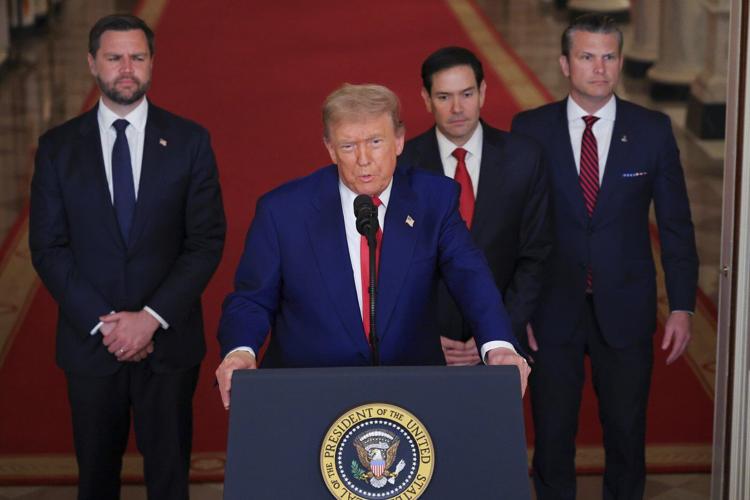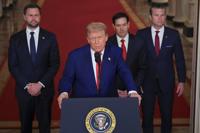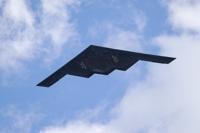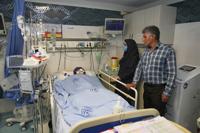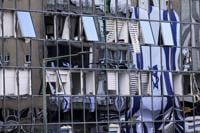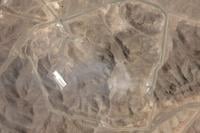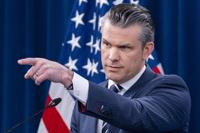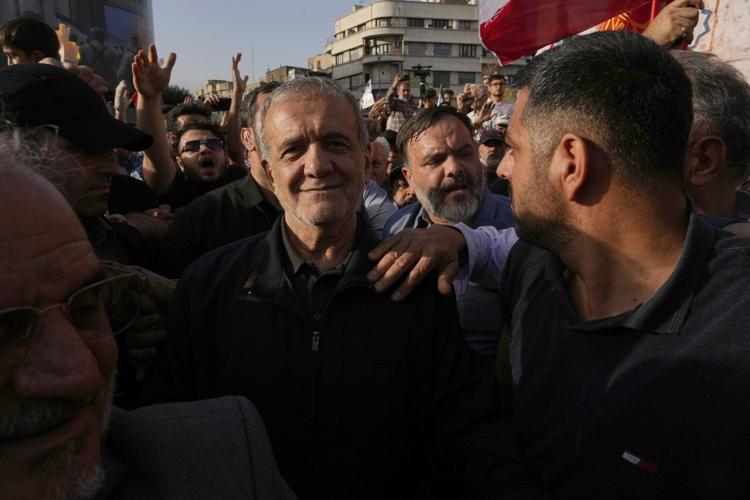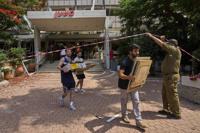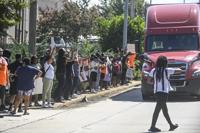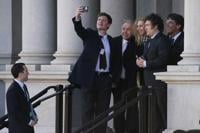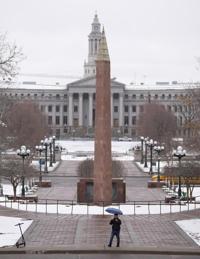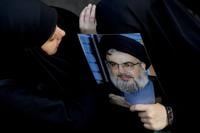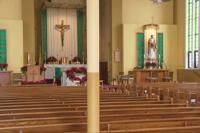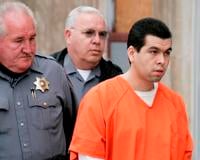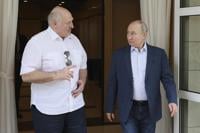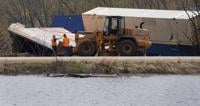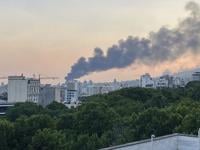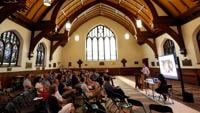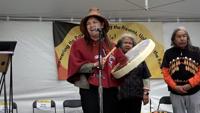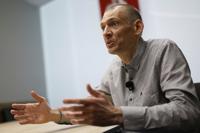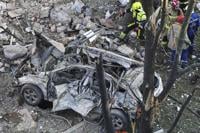DUBAI, United Arab Emirates (AP) — The world grappled Sunday with the United States inserting itself into Israel's war by attacking Iranian nuclear sites, an operation that raised urgent questions about what remained of Tehran’s nuclear program and how its weakened military might respond.
Experts warned that worldwide efforts to contain by peaceful means would be at stake in the days ahead, while fears of a wider regional conflict loomed large. The as financial markets reacted.
Iran lashed out at the U.S. for crossing “a very big red line” with its to strike the three sites with missiles and 30,000-pound .
Iran’s U.N. ambassador, Amir Saeid Iravani, told an emergency meeting of the U.N. Security Council that the U.S. "decided to destroy diplomacy,” and that the Iranian military will decide the “timing, nature and scale” of a "proportionate response.” Foreign Minister Abbas Araghchi flew to Moscow to coordinate with close ally Russia.
Tens of thousands of American troops are based in the Middle East. Ali Akbar Velayati, an adviser to Iran's supreme leader, said any country used by the U.S. to strike Iran ”will be a legitimate target for our armed forces,” the state-run IRNA news agency reported.
At first, the Trump administration indicated it wanted to restart diplomatic talks with Iran. “Let's meet directly,” Secretary of State Marco Rubio said in an interview with CBS. Defense Secretary Pete Hegseth said the U.S. “does not seek war.”
But President Donald Trump, who has warned of additional strikes if Tehran retaliates against U.S. forces, later mused about the " in Iran.
The U.S. strikes, confirmed by the Atomic Energy Organization of Iran, hit the . Iran and the U.N. nuclear watchdog said there were no immediate signs of radioactive contamination around them.
Trump asserted on his Truth Social platform that Iran’s nuclear sites sustained “monumental damage” in the attack, though an American assessment on the strikes is still underway.
“The biggest damage took place far below ground level. Bullseye!!!” he wrote.
Trump previously claimed the U.S. “completely and fully obliterated” the sites, but the Pentagon reported “sustained, extremely severe damage and destruction.” Israeli army spokesman Effie Defrin said “the damage is deep,” but an assessment with the U.S. continued.
“We are very close to achieving our goals” in removing Iran's nuclear and missile threats, Israeli Prime Minister Benjamin Netanyahu said late Sunday.
U.S. defense officials have said they are working to determine about just how much damage the strikes did. Iran as well has not said how much damage was done in the attack, though Tehran has not offered any details so far on the strikes it has faced from Israel in its war with that country.
The head of the U.N.'s International Atomic Energy Agency, Rafael Mariano Grossi, told the Security Council that no one was in a position to assess the underground damage at Fordo, which is dug deep into a mountain, but visible craters tracked with the U.S. announcements. He said IAEA inspectors should be allowed to look at the sites. The IAEA's governing board planned an emergency meeting Monday.
Grossi stressed that a path for diplomacy remained, but if that fails, “violence and destruction could reach unthinkable levels,” and global efforts at nuclear nonproliferation “could crumble.”
Satellite images analyzed Monday by The Associated Press appear to show at least one crater at the Natanz site. A hole of around 5 meters (16 feet) could be seen in images taken by Planet Labs PBC and Maxar Technologies on Sunday after the American strikes. That hole sits directly over the underground portion of the site, which includes centrifuge halls.
Iran has offered no assessment of how much damage has been done at the site. Previous Israeli strikes destroyed an above-ground centrifuge hall, as well as all of the power equipment at the site, likely cutting its electrical supply.
With the attack that Washington said was , the United States it spent decades trying to avoid. Success could mean ending Iran’s nuclear ambitions and eliminating the last significant state threat to the security of Israel, its close ally. Failure — or overreach — could plunge the U.S. into another .
For Iran’s supreme leader, it could mark the end of a campaign to transform the Islamic Republic into a greater regional power that holds enriched nuclear material a step away from weapons-grade levels. last spoke publicly on Wednesday, warning the U.S. that strikes targeting the Islamic Republic will “result in irreparable damage for them.”
Iran, battered by Israel’s largest-ever assault on it that , has limited , as of the conflict. It could attack U.S. forces stationed in the Middle East with the missiles and rockets that Israel hasn’t destroyed. It could attempt to close a key bottleneck for global oil supplies, the Strait of Hormuz, between it and Oman.
Or it could hurry to develop a nuclear weapon with what remains of its program. The Atomic Energy Organization of Iran said its program will not be stopped.
New questions about Iran’s nuclear stockpile
Iran has long maintained that its nuclear program was peaceful, and U.S. intelligence agencies have assessed that Tehran is not actively pursuing a bomb. However, Trump and Israeli leaders have argued that Iran could quickly assemble a nuclear weapon.
Israel has significantly degraded Iran’s air defenses and offensive missile capabilities and damaged its nuclear enrichment facilities. But only the U.S. military has the bunker-buster bombs that officials believe offered the best chance of destroying sites deep underground. A total of 14 were used on Natanz and Fordo, according to the Pentagon.
Experts scrambled to answer the urgent question: What has happened to Iran’s stockpile of uranium and centrifuges?
Satellite images taken by Planet Labs PBC after the U.S. strikes, analyzed by The Associated Press, show damage to the facility. Other images from Maxar Technologies suggest Iran packed the entrance tunnels to Fordo with dirt and had trucks at the facility ahead of the strikes.
Several Iranian officials, including Atomic Energy Organization of Iran spokesman Behrouz Kamalvandi, have claimed Iran removed nuclear material from targeted sites.
Before the Israeli military campaign began, Iran said it had declared a third, unknown site as a new enrichment facility.
“Questions remain as to where Iran may be storing its already enriched stocks … as these will have almost certainly been moved to hardened and undisclosed locations, out of the way of potential Israeli or U.S. strikes,” said Darya Dolzikova, a senior research fellow at the Royal United Services Institute focused on nonproliferation issues.
and calls for restraint. Egypt warned of “grave repercussions” for the region. Bahrain, home to the U.S. Navy’s Middle East-based 5th Fleet, called on Iran and the U.S. to “quickly resume talks.”
The State Department advised U.S. citizens worldwide to “exercise increased caution.”
Trump's decision and the risks
The decision to attack was a , who won the White House partly on the promise of .
But Trump also vowed that he would not allow Iran to obtain a nuclear weapon. He initially hoped that the threat of force would bring the country’s leaders to give up its nuclear program.
For Netanyahu, the strikes were the culmination of a decades-long campaign to get the U.S. to strike Israel’s chief regional rival and its disputed nuclear program. Netanyahu praised Trump, saying his decision “will change history.”
to be the only Middle Eastern country with nuclear weapons, which it has never acknowledged.
Iran and Israel trade more attacks
Israel’s military chief, Lt. Gen. Eyal Amir, called the U.S. attack a key “turning point" but added: "We still have targets to strike and objectives to complete."
Iran’s paramilitary Revolutionary Guard said it launched a , including its Khorramshahr-4, which can carry multiple warheads. Israeli authorities said more than 80 people suffered mostly minor injuries.
Late Sunday, the Israeli military said it again struck military infrastructure sites in Tehran and western Iran.
The Israeli military confirmed other attacks on Iran late Sunday which included strikes on Hamedan and Kermanshah in western Iran, as well as strikes in Tehran, Iran’s capital. Israel also hit what its military described as a missile production site in Shahroud.
Earlier, explosions boomed in Bushehr, home to Iran’s only nuclear power plant, three semiofficial media outlets reported. Israel’s military said it struck missile launchers in Bushehr, Isfahan and Ahvaz, as well as a command center in the Yazd area where it said Khorramshahr missiles were stored. Iran has not acknowledged losses of military materiel in the war so far.
Iranian state media reported air defense systems were firing in Tehran early Monday, while explosions could be heard in the nearby city of Karaj.
A social media account associated with Iran’s supreme leader, Ayatollah Ali Khamenei, published a propaganda post Monday portraying missile strikes on a darkened city with a giant skull bearing the Star of David on it. “The punishment continues,” the poster read.
Israeli strikes on Iran have killed at least 950 people and wounded 3,450 others, according to the Washington-based group Human Rights Activists. The group said of those dead, it identified 380 civilians and 253 security force personnel. In Israel, at least 24 people have been killed and over 1,000 wounded.
At Turkey’s border with Iran, one departing Iranian defended his country’s nuclear program.
“We were minding our own business,” Behnam Puran said.
___
This version corrects that the Strait of Hormuz is between Iran and Oman, not the United Arab Emirates.
___
Associated Press writers Christopher Weber in Los Angeles; Nasser Karimi, Mehdi Fattahi and Amir Vahdat in Iran; Aamer Madhani in Morristown, New Jersey; Julia Frankel in Jerusalem; Melanie Lidman in Tel Aviv, Israel; Lolita Baldor in Narragansett, Rhode Island; Samy Magdy in Cairo; Rusen Takva in Van, Turkey; Joah Boak in Washington; Edith M. Lederer at the United Nations and Suzan Fraser in Ankara, Turkey, contributed to this story.

